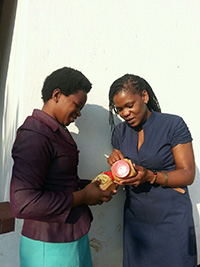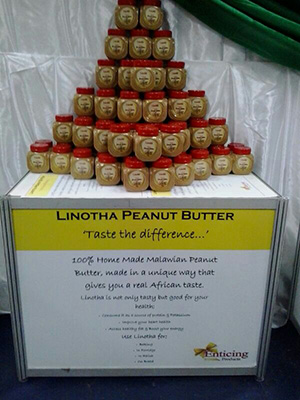Training helps peanut butter-maker get into stores
By Allison Floyd
University of Georgia, Peanut & Mycotoxin Innovation Lab
When Enid Mauluka started to make peanut butter in a home kitchen four years ago, she didn’t really think she was making a product to sell at the market. She just wanted a spread that wasn’t as sweet as the products she could buy at her local markets in Blantyre, Malawi, one that she could also use in recipes.

As friends and family began to ask for the jars, she realized she might have a business … one day.
“I didn’t think I was making a product. I enjoyed cooking and wanted a recipe without sugar in it,” she said. “After I realized how much people liked it, I bought a small peanut butter-making machine.”
Mauluka had a small home-based enterprise, but a big hurdle stood in the way of making it a sustainable business. She needed regulatory approval from the government of Malawi, a certification from the Bureau of Standards that would allow her to sell in stores.
“Once my product is on the shelves, I will have more exposure and more income. That will allow me to grow the business faster and employ more people,” Mauluka said.
She got that endorsement recently, a seal that gave her the confidence to begin to renovate her garage into a proper factory, one that will produce many more jars of Linotha spread a month and allow her to employ other women in the enterprise.

The seal of approval from the Bureau of Standards takes the Linotha brand (a local word that means “a gift that comes as a blessing”) from the informal market to the commercial grocery store, a leap that could triple Mauluka’s business.
Malawians consume lots of peanuts – or groundnuts as they are called in the southern African country – and most of them are grown and processed by local women. Groundnut staples like flour, oil and, of course, peanut butter often are manufactured in home kitchens that aren’t equipped to produce a pure product. Homemade products can contain bacteria and other contaminants, as well as inconsistent fat content, color, texture, aroma and flavor.
Last year, Mauluka and a dozen other small-scale processors attended a training designed by Tchiwiye Moyo-Chunda, a master’s student at Lilongwe University of Agriculture and Natural Resources. Moyo-Chunda, whose degree was funded by the Feed the Future Peanut & Mycotoxin Innovation Lab, tested peanut products from around Malawi for quality deficiencies and contamination, then designed a workshop to help processors improve.
She invited the processors who provided initial samples to an intensive four-day training to learn about the problems she found and how to follow best practices to prevent those short-comings.
Mauluka already was focused on creating a safe, tasty product. She’d researched on the Internet and met with the Bureau of Standards twice to learn about the safeguards that she needed to meet to become certified. The four-day training put all the pieces together.
“It’s difficult to learn all this on your own, in your spare time,” she said. “This was an intensive training. You learn a lot in a very short period of time.
“If I want to improve my business, I have to learn.”

Mauluka is renovating a garage into a four-room factory that will provide the separation necessary for a completely sanitary production space.
With a bachelor’s degree in business administration and a career in marketing, Mauluka was better prepared to start a business than many women processors in southern Africa. With interest rates hovering around 35%, finding capital to improve processing facilities is out of reach to many small-scale processors.
Through sacrifice and saving, Mauluka was able to save a nest egg for the business, all while working full-time, raising two young daughters and selling around $1,400 in product last year. Within another year, she plans to buy a plot of land for a bigger factory.
“The major challenge is resources,” she said. “I am working and did most of this all from savings. The major challenge is start-up capital.”
Two of the other processors who participated in the training have become pre-certified by the Bureau of Standards on their way to full certification.
Published November 30, 2016
